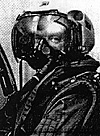 The newest, most important development in air combat maneuvering has nothing to do with a weapon or airframe. It's a sight. Just as the
reflector replaced the ring-and bead sight, and the lead-computing sight replaced that, the helmet-mounted sight improves the flexibility of many
IR missiles.
The newest, most important development in air combat maneuvering has nothing to do with a weapon or airframe. It's a sight. Just as the
reflector replaced the ring-and bead sight, and the lead-computing sight replaced that, the helmet-mounted sight improves the flexibility of many
IR missiles.
Although the idea of mounting a gunsight on a gunner's helmet first appeared on the AH-64, it was linked to a flex-mounted 30mm cannon. It was first used for a fighter/IR missile combination by the South Africans, with the Mirage F.1 and their Kukri missile. For some reason, the West never followed up on the concept. The Russians did.
A steerable IR seeker can be slewed left or right, so that its acquisition cone is no longer pointing straight ahead. It can be a great advantage in a dogfight if you no longer have to point your nose at an enemy before firing a missile. The AIM-9L and later missiles have a steerable head, but it must be done from controls on the stick and instrument panel. While it is not complex, it harder than a standard IR missile shot, which means that in a split-second dogfight, it will not be used frequently.
With a steerable seeker and a helmet sight the pilot only has to look at the target, something he's supposed to be doing anyway. Other air forces have seen the light, and in spite of a few cries of "Not Invented Here," almost everyone is moving to adopt it as quickly as possible.
The US Air Force is experimenting with a sight, which could be retrofitted to all air superiority fighters when it is perfected. The French Rafale will be delivered with such a sight for its Mica and Magic 2 missiles, and the Israelis have a sight entering production for their new Python 4 AAM. The new jointly-developed IRIS-T AAM, which will be carried on the Eurofighter and possibly other aircraft, will also be linked to a helmet sight. Indeed, the next generation of helmet sight is already under develop-ment, where the vision has a full-blown HUD on it and not just a sighting reticle.
Helmet-mounted sights allow off-axis IR missile shots in the firing plane's entire forward hemisphere. This means that planes fitted with the helmet sight/steerable seeker combination get a higher (much higher) chance to gain attack position. The new attack position formulae are:
Narrow Shot: (2 + Atk - Def) * 10% Use this formula for shots by forward-firing aircraft cannon and narrow tail chasing missiles.
Wide Shot: (4 + Atk - Def) *10% Use this formula for shots by flexible defensive guns and wide-angle tail-chasing missiles.
All-Aspect Shot: (6 + Atk - Def) * 10% Use this formula for shots by all-aspect missiles.
Shot with Helmet-Mounted Sight: (8 + Atk - Def) * 10%
In effect, the helmet-mounted sight allows a 20% greater chance of gaining attack position:
Example: An F-16C with AIM-9M missiles is dogfighting with a MiG-29 carrying R-73 [AA-11 Archer] missiles. Both planes have a Lightly loaded ATA rating of 5.0. Thus the F-16's chance of gaining firing position for a wide-angle missile shot is (6 + 5 - 5)*10% or 60%. The MiG's chance is (8 + 5 - 5)*10% = 80%.
This is an official rules modification and will appear in the upcoming fourth edition.
BT
Back to The Naval Sitrep #6 Table of Contents
Back to Naval Sitrep List of Issues
Back to MagWeb Master Magazine List
© Copyright 1999 by Larry Bond and Clash of Arms.
This article appears in MagWeb (Magazine Web) on the Internet World Wide Web.
Other military history articles and gaming articles are available at http://www.magweb.com